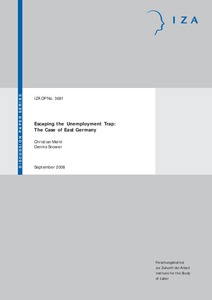Escaping the unemployment trap: the case of East Germany

Institute of Labor Economics, Bonn
IZA - Bonn
2008
29 p.
employment policy ; labour market ; unemployment
Discussion Paper Series
3681
Unemployment
English
Bibliogr.
"This paper addresses the question of why high unemployment rates tend to persist even after their proximate causes have been reversed (e.g., after wages relative to productivity have fallen). We suggest that the longer people are unemployed, the greater is their cumulative likelihood of falling into a low-productivity "trap," through the attrition of skills and work habits. We develop a model along these lines, which allows us to bridge the gap between high macroeconomic employment persistence versus relatively high microeconomic labor market flow numbers. We calibrate the model for East Germany and examine the effectiveness of three employment policies in this context: (i) a weakening of workers' position in wage negotiations due to a drop in the replacement rate or firing costs, leading to a fall in wages, (ii) hiring subsidies, and (iii) training subsidies. We show that the employment effects of these policies depend crucially on whether low-productivity traps are present. "
Digital
The ETUI is co-funded by the European Union. Views and opinions expressed are however those of the author(s) only and do not necessarily reflect those of the European Union or the ETUI.